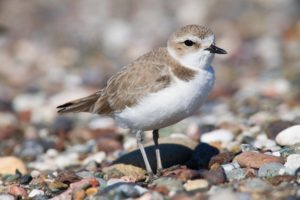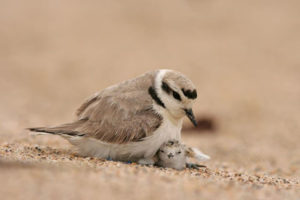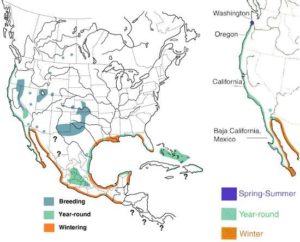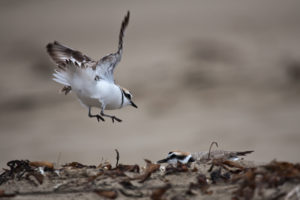Charadrius alexandrinus nivosus
- Threatened – Endangered Species Act (1993)
- Bird Species of Special Concern – California Department of Fish and Wildlife
- Near Threatened – IUCN Red List
Biology & Behavior
The western snowy plover is a small (about the size of a sparrow) shorebird with moderately long dark legs, a short neck, pale-tan backs and a white underbelly. Their diet includes small invertebrates such as crustaceans and insects such as beach hoppers and marine worms. They prefer sandy beaches and inland lakes as their habitats as these are the areas to where they migrate to nest. Female snowy plovers become able to reproduce by the time they are 6 months old. Utilizing an unusual polygamous mating system, the female deserts her mate and brood once the chicks hatch in order to initiate a new breeding attempt with a different male. Males will also often leave the young once they have fledged in order to find a new mate to renest with. Snowy plovers are able to raise two broods a year and even up to three depending on the specific habitat, local climate and abundance of forage.
This frequent process of reproduction is mainly possible due to the fact that young snowy plovers are able to run, walk, swim, and leave the nest within 3 hours of hatching. Although very independent from birth, snow plovers still depend on the care and overwatch of a parent, usually the male, for the first week of their life until they have fledged. Generally, snowy plovers can live up to 10 years of age, however the oldest snowy plover was recorded to live up 15 years old. It was spotted in the wild in California and identified by its band.
Threats
In 1993, the western snowy plover was listed as a threatened species under the Endangered Species Act of 1973. In 2012, critical habitat was designated for the species along the coasts of California, Oregon, and Washington.
The snowy plover is listed as threatened due to poor reproductive success as a result of human disturbance, predation, invasive species and inclement weather. These short-term threats, combined with the long-term nesting habitat loss from encroaching non-native sea grasses and human development, have caused major declines in nesting and breeding to the snowy plover population in general. Ultimately there are many threats to the plover population, the most dominant being from humans. Part of the reason that human disturbance is so successful in harming the snowy plovers is due to their nesting season (March through September) coinciding with the most popular time for recreational human use on the beaches along the West Coast.
Historically snowy plovers have inhabited the Pacific Coast for thousands of years. Currently the majority of the Snowy Plovers are distributed and found as part of this Pacific Coast population. Inland nesting populations are not considered part of this population, although they will often migrate to warmer coastal areas during winter months. Although the range of the snowy plover is extensive, it is the Pacific Coast population that is most at risk. Consequently, virtually all of the studies on the Snowy Plover come from the west coast.
Conservation
The management techniques to reverse the decline in snowy plover populations are primarily focused on protecting nesting areas. Nesting success has been achieved most effectively through the building of enclosures around snowy plover nesting habitats along the coast of California. These enclosures keep out avian and large mammal predators such as falcons, owls, raccoons and coyotes. Most importantly, however, these enclosures help to prevent humans from stepping on the eggs, which are often hidden from sight. In addition, these enclosures prevent loose domestic dogs on the beach from potentially destroying nests and displacing fledgling’s from their parents before they are mature enough to survive on their own. One study found that the nesting success of an isolated population of snowy plovers was raised from 25% to 68% due to the building of enclosures blocking off known nesting areas. However, the fledging success of hatched nests did not differ between enclosed and unenclosed nests. Habitat restoration or the removal of invasive sea grass has been shown to also increase the rates of nest survival.
Western Snowy Plovers in the Los Padres
Western snowy plovers have been known to nest along the Big Sur coast, where the Los Padres National Forest boundary extends to the Pacific Ocean. While that stretch of coastline was not designated as critical habitat for the species, it still represents an important nesting area. The species has also been observed in areas near the Los Padres along the Gaviota Coast in Santa Barbara County. While only representing 15% of the 300 miles of Southern California Coast, it contains a high level of biodiversity due to the unique meeting of the Transverse Ranges with the Pacific Ocean.










